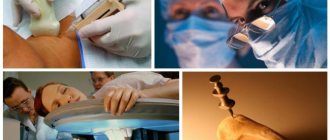Prolapse, or prolapse, of the uterus is a dangerous pathology that can significantly worsen a woman’s quality of life. The development of prolapse is possible at any age - both in young and elderly women. The main reason is a partial or complete weakening of the tone of the pelvic floor muscles due to their lack of activity in everyday life. With a calm lifestyle, the disease may not manifest itself for a long time. Frequent or difficult childbirth, congenital pathologies, injuries, genetic diseases, and excessive physical exertion can provoke an impetus for uterine prolapse.
To reduce the possibility of developing prolapse of the reproductive organ, and to prevent the problem from worsening in the early stages, it is recommended to carry out special gymnastics.
The effectiveness and basic rules of performing gymnastics for uterine prolapse
Exercises for uterine prolapse are not a panacea, but they can improve a woman’s condition, and in some cases, return the position of the organ to its place.
Performing gymnastics helps strengthen the uterus and all pelvic organs. With their help, exercises can prevent the development of the disease and stop the process of prolapse that has already begun. Exercise will help improve the functioning of internal organs, normalize metabolic processes and improve blood circulation. Exercise has a positive effect on a woman’s entire body and strengthens the immune system.
To prevent uterine prolapse and other female diseases, exercises can be done independently. As a therapeutic procedure, gymnastics is indicated only in the first and second stages of uterine prolapse. But it can only be performed in consultation with a doctor, especially if prolapse develops in an elderly woman or in the presence of other concomitant diseases. The third and fourth stages of pathology require a serious approach to treatment, and physical activity is contraindicated and can lead to aggravation of the situation. Only with the right approach will exercise be useful and help avoid disability.
You can read more about the main causes of the pathology, the features of the development, diagnosis and treatment of uterine prolapse in the article “Uterine prolapse and prolapse - symptoms, treatment, prevention and possible complications.”
Gymnastics for the prevention and treatment of uterine prolapse are different sets of exercises. Depending on the patient’s condition, the stage of prolapse, and the woman’s age, the appropriate load is selected. Each complex necessarily includes exercises to strengthen the corset of the spine and pelvis: twisting and bending forward, to the sides from different positions.
To perform gymnastics, complexes of famous gynecologists and rehabilitation specialists are recommended: Kegel, Bubnovsky, Yunusov and Atarbekov. Kegel exercises are the most popular among doctors and their patients.
Complexes of other authors
Methods for performing therapeutic exercises by other specialists have been developed. The Bubnovsky complex is designed for the general improvement of systems and organs of men and women, and is used for prolapse of the uterus, among other things. Most of the exercises are aimed at strengthening the abs.
Simple and effective physical therapy according to the Atarbekov system is designed to improve the tone of the muscles of the genital organs, abdominal wall and pelvis. The complex is suitable for women of all ages, regardless of physical fitness.
To treat and prevent uterine prolapse and other gynecological problems, women can use the complex of one specialist or combine exercises from different systems. Any choice must be agreed with the treating doctor so that the therapy brings targeted results and benefits.
When doing gymnastics when the uterus prolapses, you should not expect instant and complete healing. There may be cases when exercises alone are not enough and specialists adjust and supplement treatment with other methods.
Kegel complex
Arnold Kegel exercises have been known since the mid-twentieth century. His gymnastics are designed for:
- teaching pregnant women the ability to relax the muscles that will be involved in childbirth;
- restoration of muscle tissue stretched during labor;
- treatment of prolapse of reproductive organs;
- therapy for uncontrolled urination and defecation;
- prevention of inflammation of the reproductive system;
- improving the quality of intimate life.
Over time, Kegel exercises began to be used in the treatment of prolapse of other internal organs, in particular, nephroptosis - kidney prolapse. Gymnastics is suitable for everyone - both young girls and older women.
If the uterus prolapses, you need to empty your bladder before performing Kegel exercises. Exercises can be done in any convenient position at home or even during work in the office - no one will notice. Charging is performed as follows.
- Reduction. 5 sec. rhythmically contract the pelvic muscles, after 5 sec. recreation. Do up to five sets of 10 repetitions. Gradually increase the time of rhythmic contraction to 10 seconds.
- Compression. Squeeze your pelvic muscles for 5–10 seconds, then relax. Repeat 10 times, gradually increase to 50. Perform the exercise 3-4 times a day.
- "Kegel lift." Gradually tighten all the muscles of the small pelvis to the maximum. Between each stage you need to “stop on the floor.” When you reach the “top floor”, gradually relax, with stops as when climbing.
- "Wave". Alternately tense and relax the walls of the vagina and anus. The duration of the exercise is up to 20 seconds, starting with minimal load.
- Interrupt. You can perform this while urinating: straining the vaginal muscles, stop the stream, and then continue the process. Repeat several times. You cannot use your abs and buttocks. Once you learn to identify the correct muscle, this Kegel exercise can be done at any time without urinating.
- "Bag". Spread your legs wide, squat, keep your knees at right angles. Imagine a heavy bag between your legs, strongly squeezing the vaginal walls, “grab” it by the handles, freeze for a while and gradually rise. Repeat up to 10 times.
- Positioning. This Kegel exercise is especially useful during pregnancy to prepare for childbirth. It is recommended to combine it with breathing exercises. Relax, hold your breath, then push a little. Repeat 3 times, gradually increasing to 10 times. You can do the exercise lying down, sitting, or on all fours.
If necessary, cleanse your intestines before exercising. Evacuation should be natural, no need to resort to enemas or laxative prescriptions.
Another Kegel exercise in the photo:
To increase the load, it is recommended to supplement Kegel exercises with a jade egg. Such a home exercise machine will not only complicate the workout, but will also make it clear how correctly the muscles of the lower section work. If the exercise is performed correctly, the ball should not fall out of the vagina spontaneously. The egg can be replaced with a silicone ball from a specialized store for adults. Regular exercises using vaginal exercise machines speed up the tightening and strengthening of the back and front walls of the vagina. In addition, according to the reviews of many women, intimate life is also changing for the better. At the same time, you should always remember about hygiene - exercise equipment should be washed thoroughly before and after use.
Features of performing Dr. Kegel exercises with a prolapsed uterus
If the uterus has prolapsed, Kegel exercises can be done at any time, if this practice is approved by your doctor, while walking or rocking your baby, watching TV or traveling on public transport. There is no need for special clothing or additional equipment. All you need is your own body and the right technique. The latter determines how quickly and how effectively the result will appear.
Beginners are recommended to practice in a lying position (on their stomach or back), but if it is more convenient to contract the muscles while sitting, they are allowed to choose any position. The main conditions for success come down to regularity, correct execution, and gradual increase in loads. It is important to keep your breathing calm and not hold it. The abs and buttocks are relaxed. At first it is difficult to distinguish which muscles are working, but over time the process will become automatic.
A complete set of Kegel gymnastics for women with uterine prolapse consists of 11 methods of working the muscles. The essence comes down to alternate contraction and relaxation of the muscle group responsible for urination and maintaining organs in the pelvis. You should not take on all 11 options at once - this is too much stress for untrained muscles. At first, the two simplest and most effective ones are enough - “Bag” and “Elevator”.
The “bag” tones the muscles of the thighs, perineum and vagina. Starting position: standing. Feet are shoulder-width apart. Imagine that there is a bag loaded with shopping on the floor. The goal is to grab and lift this imaginary weight with your vaginal muscles. The task is not difficult to complete. Squat down, keeping your back straight, until your knees are bent at a 90-degree angle. Hold for a few seconds. Spread your legs slightly and tense your vaginal muscles as if you were grabbing the handles of a bag. While maintaining tension, lift the body a couple of centimeters and lower it back. Do 10 repetitions, moving higher each time.
The “lift” is performed from a lying position. Knees bent, eyes closed. The goal is to work the vaginal muscles step by step. Tighten your vaginal muscles for 3 seconds, then increase the tension, as if you were taking an elevator to the second floor, and hold still. Repeat until the “5th floor”, staying on each floor for 3 seconds at first, and after a couple of weeks for 5–10 seconds. “Having risen to the 5th floor”, you need to relax your muscles in the same way, “going down” until complete relaxation.
After the “Bag” and “Lift” have been mastered, you can, after consulting with your doctor, supplement the training with other Kegel exercises for women with prolapsed uterus. The gynecologist may recommend the following complex or part of it.
- Pushing out. Helps in the early stages of the disease. Lie on your back, bend your knees and spread your legs. Place your palms on your stomach below your navel. Imitate pushing.
- Flashing. Aimed at improving the health of the genital tract. Lie on your back or sit upright in a chair. Tighten the muscles of the vagina and anus. Hold for 5 seconds. Repeat as often as possible throughout the day.
- All muscles. The method works when the anterior wall of the uterus prolapses. Lie on your back. The knees are bent, the feet rest on the floor. Tighten the anus, perineum and vagina. Hold the tense muscles for 20–30 seconds. If you can’t meet the deadline, start with shorter periods of stress.
- SOS. Rhythmically contract the muscles of the perineum at the pace of Morse code - the first three contractions are fast, then three are slow. The cycle includes 10 repetitions without a break.
- Lighthouse. Allowed only 1.5 months after childbirth or 1 month after an abortion. Lie on your back, spread your legs wide, bend at the knees. Feet on the floor. On the count of 1, squeeze the perineum strongly, on the count of 2–6, slowly relax the muscles, on the count of 7–9, imitate pushing, on the count of 10, return to the starting position.
- Cat. Watch your breathing. Get on all fours. As you inhale, pull in your stomach and arch your back, pulling in your perineal muscles for 10 seconds. Relax as you exhale. Repeat 5 times.
The following and other Kegel exercises for women after uterine prolapse should be performed only after consultation with a gynecologist. The doctor will select a workout taking into account contraindications, tell you in detail about the technique and answer your questions if they arise.
Yunusov's exercises
When the uterus prolapses, Yunusov’s gymnastics is also useful. Exercises strengthen the corset of the spine and pelvis, increase the tone of the uterus, and have a positive effect on the elasticity of the vagina and sphincters of the anus and urethra.
Yunusov’s charging elements have been known since school, but they are also relevant in old age.
- Tilts. Place your feet shoulder-width apart, lean forward, fix a right angle. Alternately touch the opposite foot with your hands. Make 10 touches with each hand.
- Hip rotation. Hands on the belt, keeping the spine straight, draw “eights” or circles with your hips. “Draw” 10–15 circles.
- Squats. The back is straight, lower yourself to a right angle at the knees and immediately rise up without pausing. Start with 5-10 repetitions.
- Torso turns. Feet shoulder-width apart, keep them in one position. Hands on waist. Perform turns with the upper body. 10–15 times in each direction.
- "Bike". Lying on your back, imitate pedaling. The legs are raised 45 degrees, alternately bent to a right angle at the knees. At the initial stage, 10–15 repetitions.
- Rolling. Lying on your back, clasp your arms around your legs bent at the knees. Take turns rolling from side to side, 10 times in each direction. For older women, the exercise may be difficult.
Rules for performing exercises
To start doing gymnastics when the uterus prolapses, no special conditions or preparation are required. You need to stock up on a mat, a neck cushion and wear comfortable clothes. Do the exercises while lying on your back, on your stomach or sitting.
To achieve positive dynamics in the treatment of uterine prolapse, it is necessary to take into account several recommendations:
• you need to perform the exercises on an empty stomach;
• empty your bladder before class;
• you need to start with several classes a week, gradually moving to training more than once a day with increasing load, amplitude and duration;
• breathing is calm;
• control the tension of the buttocks and abs;
• the stomach is relaxed, the navel is motionless;
• legs and buttocks are relaxed, the pelvic floor muscles are functioning.
At the initial stage, it is difficult to recognize the differences in the work of different types of muscles in the perineal area. Regular exercise will help you work on specific groups of pelvic floor muscles.
The pelvic floor muscles play a major role in maintaining the anatomically correct location of the pelvic organs.
Bubnovsky's exercises
Gymnastics according to Bubnovsky prevents the consequences of organ prolapse and relapses of the disease. Charging in general improves the functioning of all systems and the well-being of women, including in old age.
The complex consists of the following physical exercises.
- Raising the pelvis. Lie on the floor, bend your knees, place your arms along your body. Slowly raise your hips up, hold for a while, slowly lower down 5-10 times.
- Raising the pelvis and shoulder girdle. Lie on your back, put your hands behind your head, clasp your fingers in a lock at the back of your head. Raise your legs 45 degrees, exhale, and reach your knees with your elbows. The shoulders and pelvis rise at this time. Return to IP (starting position), legs remain elevated. Repeat 5-10 times.
- "Tail wag." Pose on all fours, feet raised. Rock, turning your hips and feet in opposite directions, 10-15 times each.
- "Butterfly" lying down. Position - on your back, legs bent at the knees, feet pressed to each other and pulled up to the groin. Spread your knees to the sides and swing them lightly 15–20 times.
- "Scissors". Lying on your back, raise your legs 45 degrees and imitate scissors. Perform 10–15 times.
- "Bike". After the “scissors” you can immediately “change” to the “bicycle”. IP - on your back, legs raised. Alternately bend your knees and extend your toes. Do 10–15 repetitions.
Attention! An important condition for proper exercise is breathing: take a deep breath through the nose to relax, exhale slowly through the mouth to load.
Why is uterine prolapse dangerous?
The development of pathology leads to a gradual movement of the uterus lower and lower in relation to the normal state. As the disease progresses, neighboring organs suffer - the urethra, bladder and rectum are deformed and displaced, and the upper third of the vagina changes its shape. Other negative consequences - the outflow of blood in the pelvis is disrupted, the large intestine and ureters undergo secondary changes.
The more advanced the disease, the more associated negative consequences appear. Prolapse develops in stages, each stage of four is accompanied by specific symptoms:
- The cervix is below the normal level, but does not extend beyond the vagina.
- The cervix moves out of the vagina due to straining. Tension can be anything - coughing, lifting heavy objects, etc.
- The cervix and part of the uterus come out at rest and do not reduce on their own.
- The uterus, along with the vaginal walls, protrude outward, which is considered a complete prolapse.
In its advanced form, the pathology is accompanied by serious discomfort. Menstruation is painful, the woman constantly experiences aching pain, feels difficulty in the process of defecation, and experiences urinary incontinence. The volume and quality of vaginal discharge changes, there is a risk of cystitis, and the tissue of the prolapsed uterus is damaged, inflamed and bleeding.
Atarbekov’s exercises for young and older women
Exercise therapy using the Atarbekov method effectively helps with pelvic organ prolapse in the early stages. The charging complex is simple and has virtually no contraindications. Therefore, even in old age you can follow this technique.
Exercises while standing
- Squeezing the muscles of the perineum. Feet together, tighten the muscles of the perineum as much as possible. Hold for 10 seconds, then slowly relax. To complicate the exercise, a fabric roller is clamped between the legs. Start gymnastics with 5 approaches, gradually increasing to 10.
- Swing to the sides. Leaning on the back of a chair, standing with your side to it, raise your leg. Then turn around and repeat the same with the other leg. While performing the exercise, simultaneously engage the muscles of the lower abdomen. Repeat with each leg 10 times.
- Swing back. Swinging back with each leg in turn, simultaneously raise your arms up. Perform 10–15 times with each leg.
- "Martin". Focus on one leg, move the other as far back as possible. Bend your torso forward. Maintain the position for 10 seconds, then change legs, repeat 10 times. Elderly people should perform this exercise with caution.
- Walking in place. Walk, raising your knees high for 5-10 minutes.
- Turns. Arms to the sides, twist your torso to the sides. Keep your back straight. Do 15–20 repetitions.
- Tilts:
- Feet shoulder width apart. When bending over, alternately touch the opposite foot with one hand and move the other to the side. Perform 10–15 times with each hand.
- Starting position, hands on the belt. Bend to the sides and slide your hands over your thighs.
Exercises on the floor
To perform gymnastics on the floor, a mat is useful.
- "Fold". Sitting on the floor, bend over with your legs straight and slowly rise up. Repeat - 10-15 times.
- Side bends. Sitting flat on the floor, legs spread wide apart. Use the opposite hand to reach the foot, and lift the other hand up. Perform 5-10 times with each hand.
- "Butterfly". Sit up straight, legs apart. Connect your feet, spread your knees. Pull your feet as close to your perineum as possible. Return to starting position. Repeat 5-10 times.
- " Birch". Lie on the mat, supporting yourself with your hands behind your back, raise your legs and lower torso vertically. The goal is to hold this position for 30–45 seconds. Perform 6–7 times. An elderly lady may need support.
Tibetan massage and acupuncture will help strengthen the results of the exercises. Proper nutrition is an important addition at any age.
Abdominal vacuum
In addition to the listed methods, you can perform an exercise for the abdomen that is effective at any age - “vacuum”. Regular exercise helps reduce waist circumference, strengthen the diaphragm muscles, develop abdominal muscles, and even improve metabolism and posture. The exercise is performed on an empty stomach. The essence of the technique is to maximally blow out air from the lungs while simultaneously drawing the stomach inward. We stay in this position for 10–15 seconds, slowly exhale air through our nose and relax our muscles. Then we take a few breaths with the diaphragm and repeat the exercise from the beginning.
What precautions should you take?
In order to prevent stages 1 and 2 of uterine prolapse, you can exercise without consulting a doctor. If complications are identified or the disease has reached stages 3–4, consultation with specialized specialists (gynecologist, urologist and proctologist) is mandatory. Otherwise, you can injure or injure the uterus.
There are a number of contraindications for training. The ban applies to the following conditions:
- postoperative period (time is determined by the attending physician);
- acute manifestation of various diseases;
- inflammation, diseases of the genitourinary system;
- tumors.
Physical activity is prohibited at any stage of prolapse. We are talking about activities such as:
- moving large objects at home, lifting heavy objects at home and in the gym;
- rocking the press;
- platform push-ups;
- jumping, running.
Performing Kegel gymnastics for women with prolapse of the uterus does not require visiting the gym, the presence of equipment and exercise equipment. All that is required is a yoga mat or comfortable floor mat, a special neck cushion, and comfortable clothing. The main part of the training is performed from a lying position, but if it is more convenient to control the muscles while sitting, you can do it that way.
From the first lessons, it will be difficult to keep some muscles tense while relaxing the others. However, it is important to control the execution technique in order to achieve the desired tension. This is the only way to count on the effectiveness of the technique.
How effective Kegel gymnastics is for women with uterine prolapse can only be found out from personal experience. In each case, the duration of work on yourself is different. Much depends on the woman’s age, general health, history of pathologies and other factors. But if you make an effort and exercise regularly, your health will definitely improve. Be sure to discuss your plans with your doctor before you start exercising.











